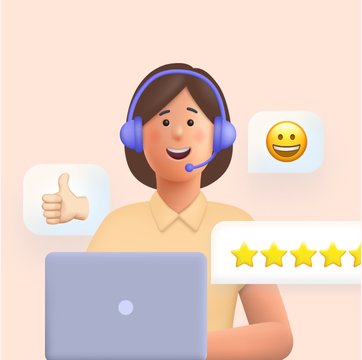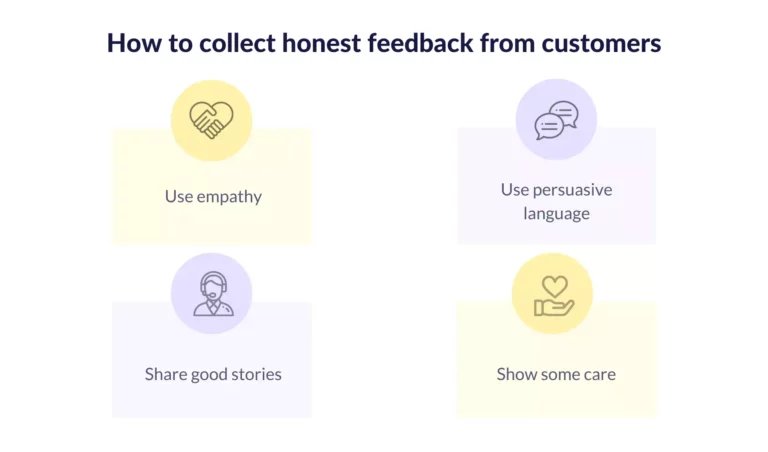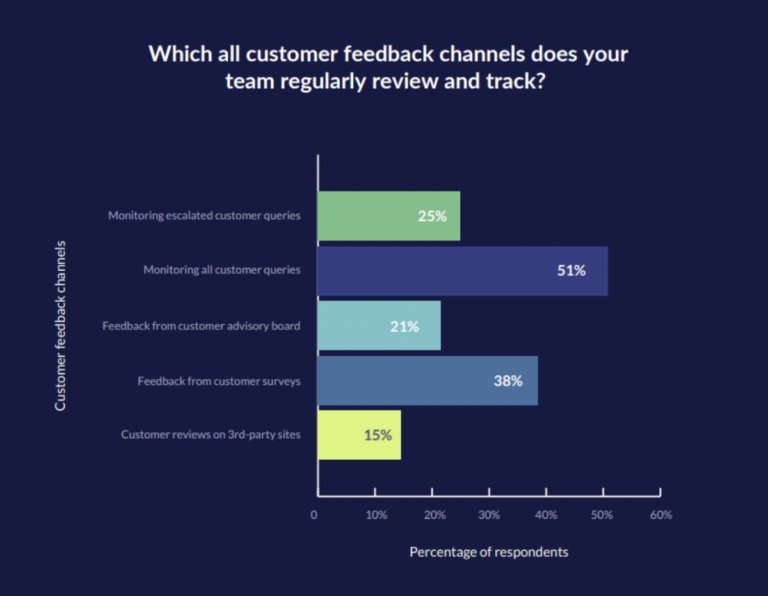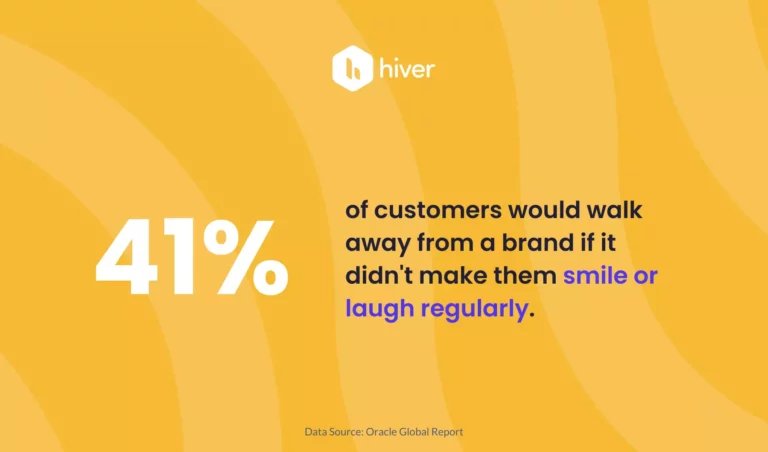Why Customer Experience Marketing is your Biggest Asset?

Table of contents
Customer acquisition is costly.
Advertisements, promotions, demonstrations, exhibitions, free product sampling, and giveaways all eat away from your marketing budget.
In June 2022, Statista calculated that the global marketing and advertising revenue would amount to $600 billion — a figure tipped to exceed $750 billion by 2024.
This is a considerable investment, and many companies will need to think carefully about how they spend their marketing budgets in the future.
But did you know that you can do great marketing without spending so much money?
Great customer experience can be an organization’s most effective marketing strategy.
Why?
A study by Glance says you have a 60% to 70% chance of selling to an existing customer, while you only have a 5% to 20% chance of selling to a new prospect. In other words, acquiring a new customer is six to seven times more costly than keeping an existing one.
You don’t need a huge budget to create a customer experience-driven brand.
We’re going to dispel the myth that you must spend more to increase brand awareness and win new customers. Read on and learn how to elevate your customer experience marketing by using customers as your biggest asset.
Table of Contents
- 1. Market to real humans, not businesses
- 2. Make word of mouth your goldmine
- 3. Stay on top of customer reviews
- 4. Focus on building relationships from first-time purchases
- 5. Use humor to engage with customers
- 6. Share case studies
- 7. Employ a Chief Experience Officer
- Level up your customer experience marketing with Hiver
1. Market to real humans, not businesses
A remarkable customer experience is your best sales and marketing strategy.
Creating a customer strategy, an exceptional customer journey, and understanding what they think of you are vital to business success. There is no better initiative to improve products, services, and support than collecting feedback in real-time (and taking action) directly from the people that do business with you.
Your customers are not just another number in your database. They are people, and if you want to collect authentic feedback from them to improve your business, sending a generic “Dear customer” survey won’t cut it.
Here are 4 ways how you can collect real and honest feedback:
- Use empathy: This is a powerful emotion to invite the desired response from your customers. Emotions and memory are joined together. When you trigger a customer’s sentiment, they are more likely to remember your product.
- Use persuasive language: Show your customers what’s in it for them. Sharing what problems your business will solve can optimize their decision to buy.
- Share good stories: People love a good story! When your customers hear a good story about your product, they can relate it to their situation, convincing them to buy.
- Show some care: Marketing that’s customer-centric shows you care. Create a deeper level of user experience that shows you are interested in them as real humans, not just as transactions.

Dan Gingiss, a renowned CX keynote speaker, advises, “If you want to stand out from the crowd, as a potential employee, salesperson, or business owner, figure out what makes you unique and then tell people about it. We do business with people we like, and sharing your personal stories makes you instantly likable.”
2. Make word of mouth your goldmine
The Semrush blog reports that word-of-mouth drives $6 trillion in annual global spending and is responsible for 13% of all sales. This shows that it plays an essential role in customer experience marketing.
Family and friends’ recommendations of excellent products influence people’s purchase decisions. The blog also shows that 88% of people had the highest trust in a brand when a friend or family member recommended it.
Sounds good?
Let’s take a look at Pinterest. Pinterest thrives on user-generated content using its ‘Pin-It-Forward’ marketing campaign.
By combining word-of-mouth marketing and leveraging the growing community of Pinterest users (people and brands),they could grow from 3,000 to more than 73 million users!
Here’s the thing:
Advice on using your product is much more powerful when it’s coming straight from your customers’ mouths rather than your marketing team. It can also help overcome possible objections to using your product.
3. Stay on top of customer reviews
Are you keeping an eye on what your customer base is saying?
You can’t monitor conversations offline, but you can watch customer feedback online.
Your customers share their product feedback, suggestions, and recommendations online, through Tweets, Facebook posts, and more commonly in B2B SaaS, third-party review sites.
Customer reviews are perhaps one of the most effective marketing tools. Still, only 15% of companies track customer feedback from third-party review sites – missing out on a huge opportunity for customer experience marketing! Leverage a QR code generator to create custom feedback QR codes that customers can quickly scan to submit their reviews. While there are numerous places to implement these QR codes for effective customer feedback collection, ensure you use them wherever possible such as as a part of your email signatures, on your website, etc.

Not sure how to use customer reviews in your marketing?
Here are 4 quick ideas:
- Add reviews to marketing emails: Builds trust and fosters an excellent reputation.
- Insert reviews into your blog posts: Reading a customer review will help drive traffic down your sales funnel.
- Showcase a case study: Highlight how your product has provided a solution to a specific customer pain point.
- Turn customers into brand ambassadors: Let your customers do the talking!
Here’s the thing about customer reviews:
You can’t control what customers say about you.
What’s more, the average customer who has a bad experience tells 8 to 16 people about it. However, you can use negative customer feedback to your advantage.
Responding to negative comments allows you to let your unhappy customers know that their opinions have been acknowledged and could possibly prevent churn.
Your customers are your biggest influencers. Develop processes that pay attention to customer reviews – they’re an excellent source for building social proof.
Listen to what your customers are talking about your brand, both positive and negative. Give them the time, attention, empathy, and value they deserve.
4. Focus on building relationships from first-time purchases
Building authentic relationships with new and existing customers is essential to creating a great customer experience.
A report by Microsoft shows that 96% of customers say customer support is essential in their choice of brand loyalty. Similarly, Glance shows that loyal customers are worth up to 10 times as much as their first purchase.
The problem?
Research done by Gartner shows that some 70% of customer experience leaders struggle to design projects that increase customer loyalty and achieve results.
So, how can you develop excellent customer relationships?
- Practice good customer communication: Stay in touch and keep up customer engagement with progress and developments. For example, you may have a new product or service that will suit your customer’s needs–promote it by sharing the benefits.
- Encourage honest feedback: While positive reviews motivate your team and put your brand in good light, negative ones can showcase improvement opportunities.
- Be approachable: There’s nothing worse than stuffy and rude staff, so use your friendliest team members to foster good relationships and meet customer expectations.
Dan Gingiss rightly points out, “Every point of communication between a business and its customers is an opportunity to enhance the customer experience.”
When you surpass expectations, it results in higher customer satisfaction, loyalty, and valuable peer-to-peer recommendations leading to lower customer acquisition costs.
5. Use humor to engage with customers
Providing a great customer experience is crucial in keeping customers satisfied, happy, and returning again and again.
Hiver’s benchmark report found that 41% of teams consider customer satisfaction scores (CSAT) as their most important KPI.
Your product may be more expensive than your competitors, but if you provide a great overall customer experience, they often do the marketing for you.
Using humor in your marketing is a growing trend. Moreover, a global report by Oracle concluded that “People want brands to make them smile and laugh, but business leaders admit their brands rarely use humor to engage with customers.”
Hubspot surveyed that around 83% of companies that believe it’s essential to make customers happy also experience substantial revenue growth. But here’s our disclaimer: humor is perceived differently by different people. What one person finds funny, another person might find offensive, or vice versa!

6. Share case studies
Case studies are an excellent tool to bring potential new clients by sharing extraordinary personalized experiences. Over 63% of B2B marketing professionals now rate case studies as an effective content marketing tool.
More recently, HubSpot’s State of Marketing Report said that 13% of marketers name case studies as one of the core forms of media used within their content strategy.
After reading a case study, an individual can get closer to deciding whether or not to invest in your product or service.
For example, a potential customer may be swaying back and forth, unsure whether to make that purchase from you or your competitor–a case study or any other social media post can influence their decision.
Use case studies to demonstrate customer satisfaction, capture a range of perspectives from existing customers and share great customer experiences. It allows new customers to understand your product better and reduce any bias.
Here’s what to include in your customer experience case study:
- Overview: Provide background context for the story.
- Challenge: Describe the primary difficulty faced by your customer.
- Solution: Identify your product or service being used. Link to relevant pages on your website.
- Impact: Emphasize the most impactful advantages. Describe the difference it made to your customer.
- Result: Detail the specific outcomes the customer earned. Use their own words.
Remember:
Case studies are not about you; they’re all about your customer.
Reinforce your customer’s voice–it can build trust, and customer retention, gain exposure and increase sales.
7. Employ a Chief Experience Officer
Harvard Business Review makes the case that every company should have a Chief Experience Officer.
Why? Our research report revealed that 30% of consumers would not give brands more than one chance after a bad customer service experience. Forbes shows that ultimately 22% of Fortune 100 companies have a C-level customer officer, compared to the CCO Council ranked 10% of Fortune 500.
Employing a Chief Experience Officer (CXO) combines leadership skills with a passion for providing a consistent, positive customer experience. It’s their job to organize and develop tools to measure your customers’ thoughts about the product or service you provide.
They will work alongside sales and marketing teams to ensure customers have a consistent and good customer experience.
Be one of the 73% of organizations with an above-average customer experience and perform better financially than your competitors.
Level up your customer experience marketing with Hiver
Businesses that keep their finger on the pulse of the customer touchpoints are the ones that can turn expectations into extraordinary customer experiences — there’s no doubt about it.
Providing a consistent customer experience is your biggest marketing channel. Leverage customer experience into your marketing strategy – it makes for one of the best and most authentic marketing campaigns possible.
The bottom line?
Your customers are your biggest influencers. Treat them right, exceed expectations, and they’ll continue to do business with you for years to come.
Ready to level up your customer experience marketing?
Try Hiver. Companies like Upwork, Canva, and Harvard University are already using Hiver’s customer service software to improve customer interactions.
Hiver offers a free plan that helps you manage customer support at zero cost. The paid plans start at $19/user/month.
Sign up for a free trial and start delivering a better experience to your customers today!
































